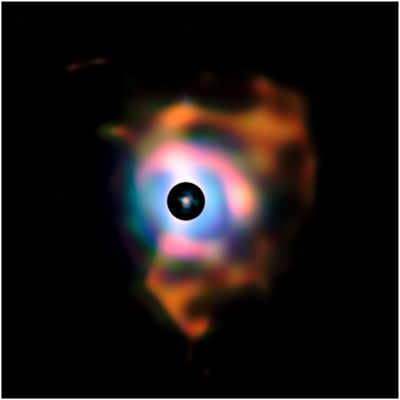23 August 2011

An infrared image of a huge cloud surrounding a gigantic star
The image, acquired by the Very Large Telescope observatory, reveals a beautiful huge nebula, surrounding a giant star, known as Betelgeuse. The black in the middle corresponds to a very bright part of the image that was masked to allow the fainter nebula to be seen. The small red circle in the center represents the location of Betelgeuse. The nebula is believed to have been ejected by Betelgeuse.
Credit: ESO/P. Kervella
The European Southern Observatory (ESO) recently published an amazing image of a gigantic red star, known as Betelgeuse. (The name of this star comes from Arabic.) The image, acquired by a team of astronomers, observing with ESO’s Very Large Telescope (VLT), shows a previously unseen large glowing nebula around Betelgeuse. This nebula, which resembles flames bursting from Betelgeuse, is formed because its star expels its gaseous material into space.
Betelgeuse is classified as a red supergiant star. Red supergiants are the largest of all stellar classes. Betelgeuse’s distinctively reddish hue is due to its low temperature, since red stars are the coolest of all stars, with temperatures of about 3,500 C. Betelgeuse is a star of the prominent winter constellation Orion, and is the 8th brightest star in the sky. Betelgeuse is estimated to be about 20 times more massive than the Sun, and its diameter is over 1,000 times the solar diameter.
The VLT image shows the surrounding nebula is extending for 60 billion km from the star's surface. The nebula cannot be detected in visual light, as it is hidden in the glare of brilliant Betelgeuse, but it can be imaged in infrared light.
Red supergiants like Betelgeuse are in late stages of their evolution. When a low- or intermediate-mass star consumes its nuclear fuel of hydrogen, it swells, and cools. This evolutionary stage is termed the red giant phase, since the star becomes much larger in size, and glows in red. The Sun, a low mass star, is expected to become a red giant, within about 5 billion years. A massive star grows even larger in size, evolving into a red supergiant, when it exhausts its core hydrogen. Red giants and supergiants shed prodigious amounts of material into space.
The VLT consists of four large telescopes, each 8.2 m in aperture, and four smaller, 1.8 m in aperture, telescopes. The VLT telescopes can, by applying sophisticated optical techniques, act as a single very large telescope. The VLT is located atop Paranal Mountain (over 2,600 m in altitude), in Chile. The ESO is an intergovernmental research organization for astronomy. Its 15 member states are 14 European countries and Brazil.
References
The Flames of Betelgeuse, ESO’s Website
Wikipedia
Aymen Mohamed Ibrahem
Senior Astronomy Specialist